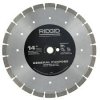Eaglecliff
Registered
In order to build my raised trackwork I can, and from time to time do, cut rockery stone (usually local sandstone of varying consistencies) using a bolster (cold chisel for cutting house bricks) and a one-and-a-half pound hammer. This is fine for rough work but does not guarantee a precise edge with sufficient accuracy when necessary. I am wondering if my very heavy angle grinder would do the trick, or is there a type of handsaw or hacksaw blade which would not be blunted within the first few stokes?





